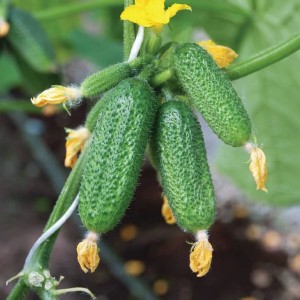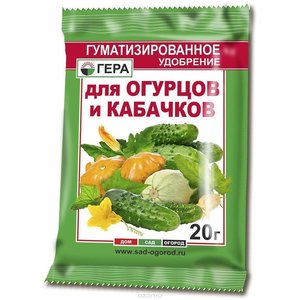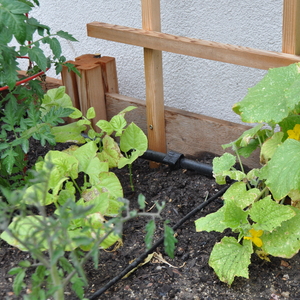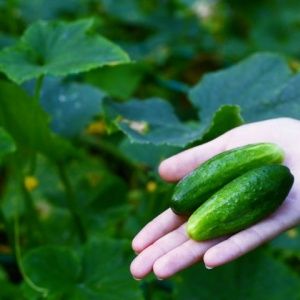The most effective recipes for feeding cucumbers during fruiting
For a good harvest of cucumbers, you need to provide your plants with warm, moist soil that is rich in nutrients. To keep the soil warm, manure or humus is introduced into it in the spring, which will warm the soil. Regular watering will provide moisture. And, of course, you can't do without fertilizers. With what feed the cucumbers during fruiting? We will consider this issue in detail in our article.
The content of the article
The value of different types of fertilizers
The yield of a crop depends on the fertility of the soil. To enrich the soil with nutrients, mineral and organic fertilizers are applied.
Mineral fertilizers make up for the lack of fluoride, potassium, calcium, magnesium. They improve the quality of the crop: the content of proteins, fats and carbohydrates, biologically active substances and ash elements.
But one cannot do with mineral fertilizers. To maintain fertility and activate microflora, organic fertilizers are needed:
- manure;

- humus;
- bird droppings;
- stubble and root residues of annual plants.
Only the complex use of mineral and organic fertilizers will preserve soil fertility and improve crop yields.
What is the risk of a lack of trace elements
The lack of trace elements often leads to chlorosis. The formation of chlorophyll, which is necessary for photosynthesis, is disrupted.
The lack of trace elements is determined by the external changes in the plant:
- Magnesium. The deficiency has a bad effect on the process of photosynthesis - the growth of the plant and the development of the root system stops. Externally, a lack of magnesium is manifested by the appearance of yellow wrinkled spots on the leaves.
- Potassium. Its deficiency leads to the cessation of growth, the fruits become watery and bitter.
- Phosphorus. The signs of deficiency do not appear immediately. Gradually, the leaf becomes smaller, becomes dark green, becomes covered with watery spots.
- Calcium. Its lack is manifested in the violation of the shape of the leaves - they curl, become lethargic. Calcium deficiency leads to the appearance of rot, which spreads to the fruit, root system and plant stem.
Fertilization periods
During the season, cucumbers are fed four times:
- Two weeks after disembarkation. Potassium-nitrogen fertilizers are used.
- During the budding period. Here, fertilizers with magnesium and boron are added to potassium-nitrogen fertilizers.
- During flowering. Fertilized with organic matter - infusion of bird droppings or mullein solution.
- In the process of fruiting. Potash fertilizers are used; later, phosphorus nutrition is added.
If fruiting decreases sharply or signs of micronutrient deficiency are visible, additional feeding can be done.
Important! When choosing the type and dosage of fertilizer, take into account the composition of the soil, the appearance of the plant and weather conditions.
Fertilizing cucumbers during fruiting
During the fruiting period, cucumbers spend all their strength on the formation of fruits. Plants can be supported with additional nutrients.
Root
In summer, in hot dry weather, fertilizers are applied at the root. The developed root system absorbs well the liquid form of fertilizer and easily assimilates nutrients.
Attention! Before applying root dressings, cucumbers are spilled with clean water so that the roots do not get burned.
Foliar
In August - September, you can prolong the fruiting of cucumbers... For this:
- collect fruits regularly;

- the plants are mulched with cut grass, creating a heat layer;
- they switch to foliar dressing - at low temperatures, the root system of cucumbers does not absorb nutrition well, therefore fertilizers are applied by spraying the leaves.
Foliar dressing is carried out in the evening or in cloudy weather with a spray that gives fine spray or even fog. The longer the solution is on the leaves, the more nutrients they will receive.
Spray the leaves on both sides. The underside of the leaf absorbs more intensively than the top, due to the greater number of stomata.
Recipes and schemes for the use of dressings
Summer residents use a huge range of fertilizers. Among them are ready-made complex mineral formulations, organic dressings and homemade solutions.
Yeast
The most effective home dressing.
Composition:
- 1 pack of raw yeast (100 g);
- 3 liters of water;
- 0.5 cups of sugar.
Everything is mixed and left for 2-3 hours. Then they dilute a glass of infusion in a bucket of water and water the plants with 0.5 liters per bush.
If only dry yeast is available, 1 tbsp. l. diluted in 10 liters of water, add 2 tbsp. l. sugar and insist for three days. Then 1 liter of the mixture is diluted in a bucket of water and watered each bush.
Important! Feeding cucumbers with yeast requires a well-heated soil to start the process of fungal reproduction.
Bread dressing
If yeast is not available, bread can be used. A loaf of bread (can be dry) is placed in a bucket of water, filled with water and left overnight. In the morning, knead the bread, stir, filter and add 30 drops of iodine. For feeding, dilute 1 liter of infusion in a bucket of water.
Milk serum
Whey is sprayed to combat bacterial diseases or watered under the root for additional nutrition.
For spraying, 2 cups of whey is diluted in 1 liter of water. Spray no more than once a month in the morning or evening.
For watering you will need:
- 1 liter of whey or sour milk;
- 10 drops of iodine;
- 10 liters of clean water.
Pour 1 liter of liquid under each bush 1 time in 10 days.
Fermented Green Fertilizer
For preparation, the cut green grass is placed in a black plastic bag, tightly closed and left for 2 days. During this time, the grass will heat up, the process of decomposition and fermentation will take place, and all pathogenic bacteria will die. Then put the grass in a bucket up to half the volume and fill it with water, leave to ferment for 2-3 hours.
Undiluted solution is poured over each bush every 2 weeks. Grass residues are used to mulch the soil around the plants.
Infusion of onion peel
150-200 g of onion husks are poured with a bucket of hot water and infused for 4 hours before cooling. Water each plant with 1 liter of solution. Cucumbers can be sprayed with the same solution.
Nitrogen fertilizing
Gardeners prefer to fertilize cucumbers with such dressings:
- urea - 1.5 tbsp. l. on a bucket of water;
- calcium nitrate - with a solution in water in a proportion of 20 g per 10 liters, sprayed every 2 weeks;
- manure of all animals;
- bird droppings;
- peat.
But it is not worth using nitrogen fertilizers too often, as they provoke the growth of green mass.
Potash dressing
Potash fertilizers are organic and mineral.
Potassium is found in organics:
- mullein and bird droppings;
- ash;
- green manure.
During fruiting it is better to use ash. In dry weather, it is bred in water and watered with bushes. In rainy times, ash is scattered around the plant.
On sale there are mineral complexes with potassium:
- Potassium humate. Dilute 3 g of powder in 10 l of water and spray the plants. Potassium humate cannot be combined with other fertilizers.
- "Kalimagnesia". Consists of potassium (30%), sulfur (17%) and magnesium (10%). Take 1 tbsp for a bucket of water. l.dry powder and stir until dissolved. Kalimagnesia is used until August to prolong fruiting.
Calcium fertilizers
During the fruiting of cucumbers, calcium is introduced with great care and only when necessary. Calcium is absorbed in the presence of nitrogen, and nitrogen fertilizers increase the accumulation of nitrates.
If there is a need for calcium, calcium nitrate is used. It is brought in dry or dissolved form in a ratio of 25 g to 15 liters of water.
Other dressings

Cucumbers often lack several elements at once.... This becomes visible when the fruits take on a bizarre, incomprehensible shape. In this case, use a complex fertilizer: dilute "Nitroammofosku" in a proportion of 2 tbsp. l. 1 liter of water and spray the leaves of the plant. You can repeat it in 7-8 days.
For phosphorus starvation, potassium monophosphate is used, which contains 50% phosphorus and 26% potassium. With its help, the period of obtaining cucumbers is extended, the plants are protected from temperature extremes and diseases. For irrigation, use a solution of 10 g of fertilizer per 10 liters of water. And for spraying, stir 5 g of the product in 10 liters of liquid.
What can not be fertilized with cucumbers during the fruiting period

During the fruiting period, it is categorically impossible to use chicken manure, which causes an increase in green mass and stepchildren, reducing flowering and fruit setting.
Nitrogen-containing fertilizers are used with caution, since cucumbers tend to accumulate nitrates in fruits.
Superphosphate is also used to a limited extent. During this time, cucumbers need sulfates and chelates. And phosphates don't work at all.
Important! "Diammofosku" is used to activate the growth of cucumbers and increase yields. Apply it only before flowering.
Conclusion
Cucumbers require attention and care. Once you have selected the right fertilizer for your growing season, use it every two weeks. Alternate watering and spraying. Then your work will be rewarded with an excellent harvest of cucumbers.